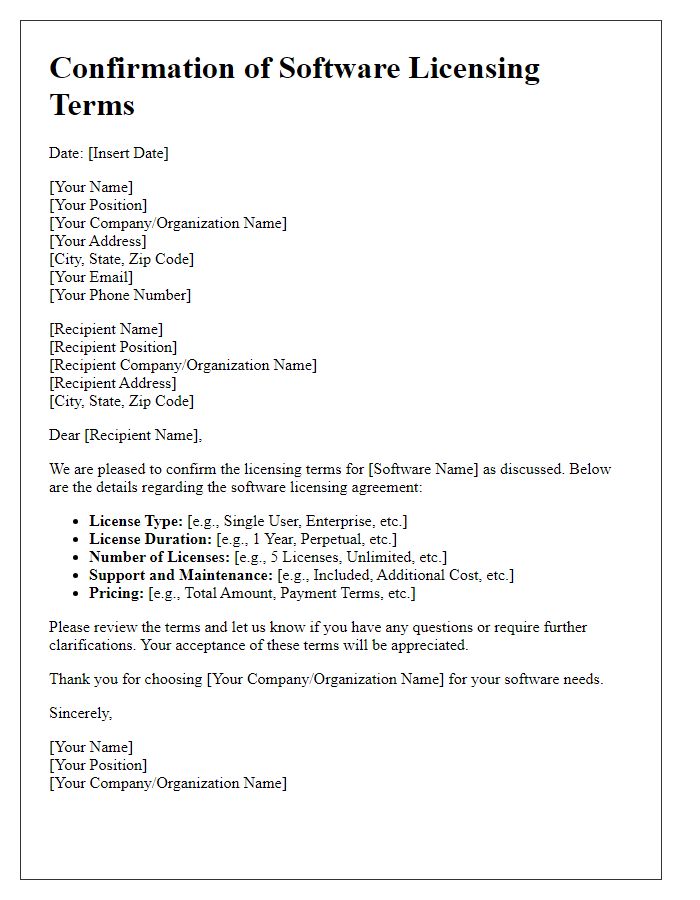Are you in need of a clear and professional confirmation letter for your software license? Crafting the perfect document can often feel daunting, but it doesn't have to be! In this article, we'll guide you through the essential elements that should be included to ensure your letter is both effective and polished. So, let's dive in and explore the best practices for confirming your software license successfully!

License Type and Scope
Software licenses encompass various types and scopes, such as proprietary licenses, open-source licenses, and subscription-based licenses. A proprietary license typically allows the end-user access to a specific set of functionalities, usually detailed in the End User License Agreement (EULA). Open-source licenses, like the GNU General Public License (GPL) or MIT License, often permit users to inspect, modify, and share the software freely under certain conditions. Subscription-based licenses, frequently seen in software as a service (SaaS) models, grant access for a defined period, typically on a monthly or annual basis. Understanding the license type and scope is crucial for ensuring compliance with the stipulated terms, affecting the usage rights within organizational environments or individual pursuits.
License Duration and Renewal Terms
In the realm of software licensing agreements, explicit details regarding license duration and renewal terms are crucial. Typically, software licenses, such as those for enterprise solutions, run for a predefined period, often ranging from one to three years. Upon nearing the expiration date, businesses must review renewal terms, which may include options for auto-renewal or renegotiation of conditions. Key elements include renewal fees, which could fluctuate based on market value or user growth, and potential penalties for lapses in coverage. Furthermore, termination clauses must clarify conditions under which either party can dissolve the agreement, ensuring mutual understanding. Regular assessments of usage against the license terms can prevent compliance issues and unauthorized use, maintaining software integrity for all involved parties.
Software Usage Rights and Restrictions
The software license agreement details the rights and restrictions associated with the use of proprietary software applications, which typically include stipulations on the number of installations permitted (often limited to a single device or multiple devices in a corporate setting), and the conditions under which end-users may access updates (usually provided through a subscription model). Compliance with usage rights, such as the prohibition of unlawful sharing, modification, or reverse-engineering of the software, is crucial for maintaining legal standing under intellectual property laws. Additionally, the agreement may outline the responsibilities of the user in reporting unauthorized use or violations, ensuring that the software provider can take appropriate action to safeguard their product. These licenses, governed by terms typically valid for one year or longer, may also include provisions for termination in cases of non-compliance or misuse, emphasizing the importance of adhering to the outlined regulations.
Payment Terms and Invoicing Details
Software license confirmation involves essential terms including payment details and invoicing processes. Phase one outlines the licensing agreement specifics, detailing the type (e.g., enterprise or individual licenses) and duration (for instance, annual or perpetual) of the software use. Payment terms include total amounts due, acceptable methods (credit cards, bank transfers), and payment schedules, often requiring upfront payments or installments. Invoicing details specify frequency (monthly, quarterly), formats (electronic or paper), and due dates, typically net 30 days upon receipt. Accurate invoicing is critical for maintaining transparent financial records and ensuring compliance with the license terms.
Support and Maintenance Provisions
Software license confirmation involves outlining specific support and maintenance provisions associated with the licensed software, typically covering aspects such as duration, response times, and included services. This may include software updates, technical assistance, user documentation, and any service level agreements (SLAs) detailing obligations from both the software provider and the licensee. Key components often involve regular maintenance checks, provision of patches and upgrades as necessary, and a dedicated support hotline or email service for troubleshooting issues. Additionally, the agreement may specify conditions under which support is available, such as business hours or emergency response times, ensuring clarity on expectations and service delivery.













Comments